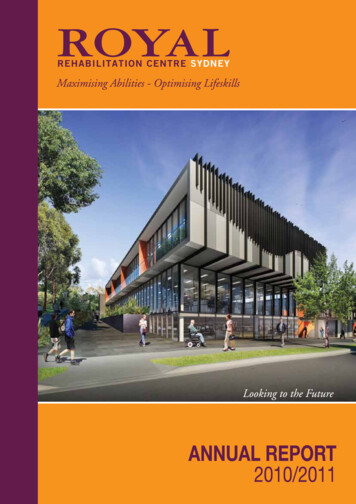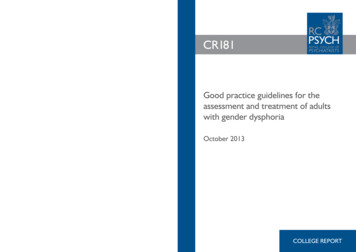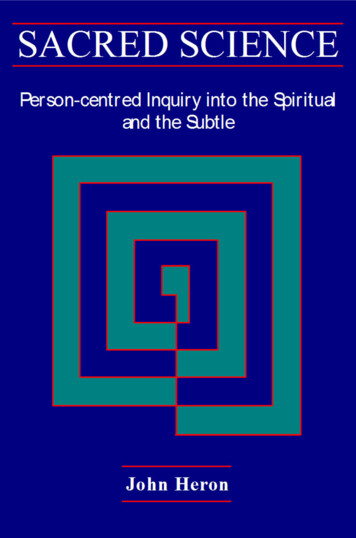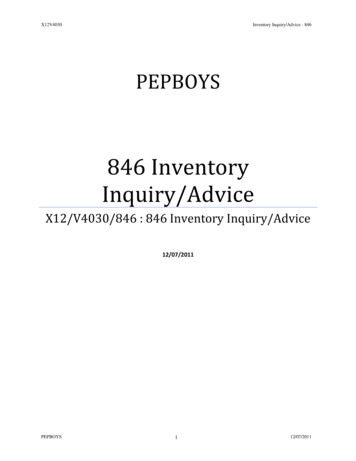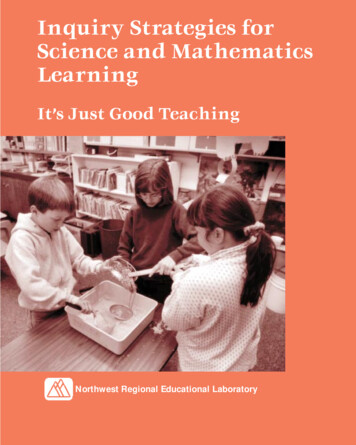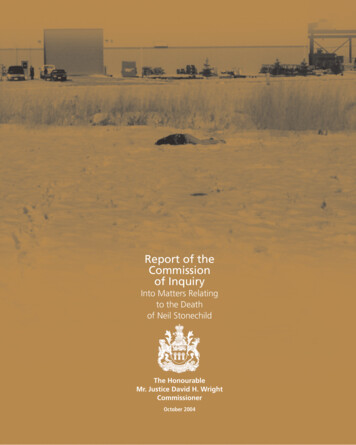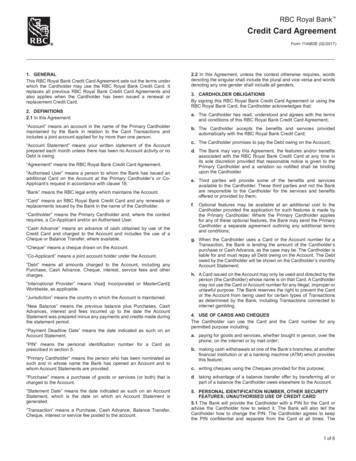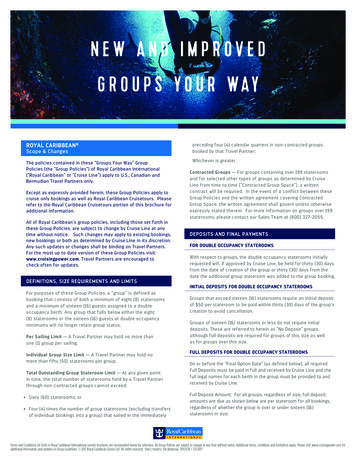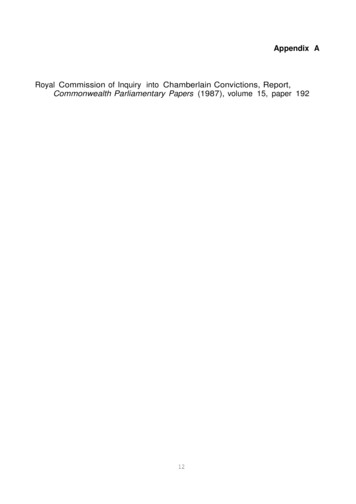
Transcription
Appendix ARoyal Commission of Inquiry into Chamberlain Convictions, Report,Commonwealth Parliamentary Papers (1987), volume 15, paper 19212
CONTENTS1ESTABLISHMENTAND PROCEEDINGSOF THE COMMISSION2THE NATURE AND SCOPE OF THE INQUIRY3PROCEEDINGS4THE EVIDENCE5THE CASE PUT TO THE JURY BY THE PROSECUTION456BLOOD547BLOOD TESTS - NATURE AND GENERAL DIFFICULTIESLEADING TO THE CONVICTIONSAT THE TRIALBLOODIN THE CAR - LAY EVIDENCEIN THE CAR - SCIENTIFICA. FINDINGS1.71113The age of any blood in the carDistinguishing specific immune-chemicalresults ftom non-specific resultsWhether non-specific reactions wash outWhether non-specific reactions will beindicated by reactions with allanti-sera·General reasons for suspecting thatreactions obtained were non-specificLimitations 0f the anti-foetal haemoglobinanti-serumResidual foetal haemoglobin in adult bloodThe necessity for detailed testing of theanti-serum before useThe testing of the anti-serum before useThe testing of the anti-serum after useThe cross-over electrophoresis testThe necessity for proper controlsDilution of samplesWhether the anti-serum was specific tofoetal haemoglobinConclusion81FINDINGSOF BABY'S BLOODTHE SPRAY PATTERN UNDER THE DASHBOARDThe various testsEvidence at the trialAppearance of the "arterial" sprayMrs Kuhl's positive testsConclusion as to the spray 00101106
2.THE CARPET ON THE DRIVER'S SIDE1063.THE OFFSIDE REAR OF THE PASSENGER SEATAND THE FLOOR BENEATH108TheThetheTheridge of the hingeflakes from the vinyl behindhingehaptoglobin tests - thepassenger seat hingeThe bracket beneath the hingeThe bolt hole area of the floorThe floor well beneath thepassenger seatThe ten cent coin found in thefloor wellConclusions4.OBJECTS IN AND ASSOCIATED WITH THE CARTheTheTheTheB.scissorstowelchamois and its containercamera bagSUPPORT FOR MRS KUHL BY OTHERS109113114117117118122123124124126130133136C. MRS KUHL'S EXPERIENCE138D.139PGM GROUPING TESTSE. WHETHER ANY BLOOD WAS FOUND1.RELIANCE UPON THE ORTHO-TOLIDINE TEST1442.FINDINGS OF HUMAN BLOOD NOT ALREADYCONSIDERED147The window handlesThe nearside hinge of thedriver's seatCamera bag - zip clasp ofmiddle compartmentF.1441471481503. WHETHER THERE WAS ANY BLOOD IN THEAREA OF THE OFFSIDE HINGE ON THEPASSENGER SEAT OR ON THE FLOOR BENEATH151THE VOLUME OF ANY BLOOD155
G.H.9EXPLANATIONS OF BLOOD IN THE CAR1581.2.160MR LENEHAN 158OTHER EXPLANATIONSCONCLUSIONS160BLOOD IN THE TENT162The items stainedThe blankets in the bassinetMr Chamberlain's sleeping bagReagan Chamberlain's parkaThe floral mattressThe tent itselfMrs Chamberlain's sleeping bagMrs Chamberlain's running shoesAidan Chamberlain's parkaThe volume of bloodWas the blood dropped directly ortransferr d from anotherblood soaked item?The distribution of the blood stainsin the tentComparison w.ith the blood on theclothingWhether the small quantity of bloodin the tent was inconsistentwith dingo involvementComparison with the quantity ofblood in the carGeneralI10STAINING ON AZARIA'S CLOTHINGDescription of stainingWhere were the injuries on Azaria's body?Did bleeding which caused the bloodstaining occur before or after Azaria'sdeath?What caused the injury which producedthe bleeding - blade or canine teeth?Professor Cameron's evidenceThe absence of tissue otherthan bloodDid the damage to the clothing occurbefore or after the blood was shedupon it?Were there human hand prints in bloodon the 71173175176180180182182187189191191193197199201
11THE DAMAGE TO AZARIA'S CLOTHINGIntroductionThe finding of the matinee jacketThe evidence at the trialAdditional evidence before the CommissionDingo experimentsPlanar arrayThe single fibre with the classicscissor cut7.aria's clothingComparisons etwP.P.nand other clothing damaged by canidsDr Griffith's experimentsThe severance in the left arm of thejumpsuitThe evidence of the forensic odontologistsDamage to the nappyAbility of a dingo to remove the clothesfrom Azaria's body12.SOIL AND VEGETABLE MATTER ON THE CLOTHING'Was the clothing buried?The origin of the soilThe origin of the plant materialConclusion13FURTHER MATTERS AFFECTING THE CLOTHINGHairs on Azaria's clothingThe absence of dingo saliva on theclothingThe place where the clothing was foundThe arrangement of the clothing 7218220221224224226229235237237238239240'{.14OTHER SIGNIFICANT EVIDENCETracking evidenceThe space blanketTracksuit pantsEvidence of Aidan ChamberlainNew evidence of Mr LoweMrs Lowe's evidenceThe blankets in the bassinetDingo activity at Ayers rockThe Ding Theory15EVIDENCE OF MR AND MRS CHAMBERLAIN242242250258263269270276279285288
16SCIENTIFIC EVIDENCE STANDARDS31017SUMMARY AND CONCLUSION322The two strands in the Crown CaseThe first strand - effect of new evidenceThe second strand - effect of new evidenceAre there doubts as to the ICESCommission of Inquiry (ChamberlainConvictions) Act 1986 andAppointment of Commissioner343BLetters Patent356CAdvertisement360DTopics and witnesses362EList of expert witnesses368FGlossary of terms relating to blood tests373A\
CHAPTER1ESTABLISHMENTAND PROCEEDINGSOF THECOMMISSIONIOn 29 October1982,in the SupremeCourtof theNorthern Territory, Alice Lynne Chamberlain was convicted ona charge of murderingher daughter Azaria at Ayers Rock on17 of Alicefather, was convicteddate,LynneMichaelLeighChamberlainandof being an accessoryafterhave always maintainedtheirthe fact to that murder.Mr and Mrs ChamberlaininnocenceTheyof the chargessoughtconvictionsanenquiryupon whichintoand, in consequence,(Chamberlain Convictions)the Parliamentthecorrectnessthe CommissionTerritory.for the establishmentin pursuanceoftheof InquirySection 3(1) ofof a CommissionInquiry having the purpose specified in s.4.1986 the Attorney-General of the NorthernAustralia,convicted.Act 1986 ("the Act") was passed byof the Northernthe Act providesthey wereofs.1.3(2)andofOn1 AprilTerritory of(3) ofthe Act
appointed ant to s.4(1) I am required to report to HisExcellency the Administrator on the conclusions to be drawnfrom the evidence and material information received by me onthe matters set forth in the recitals to the Act, which arein the following terms:"1.On 29 October 1982, in the Supreme Court ofthe Northern Territory (a)(b)Alice Lynne Chamberlain was convicted on acharge of murdering her daughter Azaria atAyers Rock on 17 August 1980; andMichael Leigh Chamberlain was convicted ofbeing an'accessory after the fact to thatmurder.2. Doubts or questions have arisen as totheir guilt or as to evidence in the trial leadingto their conviction."By Letters Patent issued by His Excellency theGovernor-General of the Commonwealth of Australia on 2 April1986 pursuant to the Royal Commissions Act 1902 (Cth), I wasappointed to be a Commissioner to inquire into the samematters as are referred to in the recitals to the Act.Copies of the Act and the Letters Patent arerespectively Appendices A and B to this report.Since I am required by the terms of the Act and ofthe Letters Patent to inquire into and report on identicalmattersit will beconvenient hereafter to refercollectively to the two inquiries as "the Inquiry" and tothe two Commissions as "the Commission".In fact the twoinquiries were conducted simultaneously.2
Mr JohnCommission.Flynn wasppointedSecretaryofthePrior to the first hearing of the Commissionadvertisements were inserted in a number of newspapers whichare referred to in Appendix C.The text of theadvertisements and dates on which they appeared are alsorecorded in that Appendix.Similar advertisements werepublished throughout Australia on 21 and 23 July 1986.,The first sitting of the Commission was held at22 Mitchell Street, Darwin on 8 May 1986, when I grantedleave for the following to appear:Mr C.A. Porter, Q.C. and Mr W.W. Caldwell to assistmeMr I. McC. Barker Q.C. and Mr M.F. Adams for theNorthern 'I'cr:dtory r.nvernment and the NorthernTerritory Police ForceMr J. Winneke, Q.C. and Mr B. Woinarski for Mr andMrs ChamberlainMr M.R. Einfeld, Q.C. and Mr R. Bennett for IanStanley Cawood, Valerie Grace Cawood, DebbieTherese Connor, Arthur Derek Roff, Francis JohnMorris, Margaret Annette Morris, and Lynette JoyBeasySubsequently, Mr Barker Q.C. announced that he alsoappeared with Ms E. Fullerton and Mr Winneke Q.C. announcedthat he also appeared with Mr. K. Crispin.3.
On 10 June 1986 Mr A.S. Gillespie-Jones Q.C.applied for leave to appear for Mr P. ward and Mr D.McNicol.Mr Gillespie-Jones stated that his clients wishedto be represented because they believed their credit mightbe attacked during the course of the Inquiry as a result ofa book written by ward relating to the events surroundingAzaria's disappearance.Mr Gillespie-Jones submitted thathis clients should be granted leave to be represented on thegrounds of natural justice.I refused leave to MrGillespie-Jones to appear because at that stage of theproceedings no allegation had been made against his clientsexcept for civil claims by several persons that they hadbeen defamed in Ward's book.I informed Mr Gillespie-Jonesthat he could renew his application for leave to appearshould subsequent events give rise to a situation where hisclients' interests caulor might be adversely affected bythe proceedings of the Commission.However, he did notrenew his application. The leave to appear granted to MrEinfeld Q.C. and Mr Bennett was withdrawn shortly after10 June 1986 as their clients no longer had any interest inthe evidence led thereafter to the Commission.I decided, without objection from any party, that Iwould admit as evidence in the proceedings before theCommission the evidence tendered at the two coronia!inquests into the death of Azaria Chamberlain and at thetrial.Senior counsel assisting me made it clear that heproposed to call as witnesses before the Commission theprincipal witnesses who had given evidence in the earlierproceedings and, with the exception of one witness who wasprevented by illness and another who had died since thetrial, all the witnesses who gave significant evidence inthe earlier proceedings also gave oral evidence before me.Since the convictions giving rise to the Commissionwere recorded in proceedings brought against Mr and Mrs4
Chamberlain in the Supreme Court of the Northern Territoryit was appropriate that a significant part of theCommission's proceedings should be heard in the Territory.Indeed, since the Commission's inquiry was so intimatelyconnected with the enforcement of the criminal law in theNorthern Territory I was reluctant to take evidenceelsewhere.Most of the non-scientific evidence was takenin Darwin because that city was as convenient as any othercity in which to take this evidence. However, there were agreat many scientific witnesses resident in Sydney,To have required these witnessesMelbourne and Adelaide.and witnesses from overseas to give their evidence and inDarwin would have considerably increased the cost of theCommission and, accordingly, I took most of their evidencein Sydney, the balance being taken in Melbourne.Theevidence of these witnesses was lengthy and, in the result,.much more time was spent taking evidence in Sydney than inDarwin.However, I was at all times conscious that it wasin the public interest that the Commission should sit in theNorthern Territory since it was embarked upon an inquiryupon matters arising out of convictions recorded there. Itwas particularly appropriate that the final addresses ofcounsel should be heard in Darwin so that members of theNorthern Territory public could, if they so wished, observethe proceedings and hear counsel's submissions on theevidence furnished to the Commission.I indicated at the outset of the Commission thatall witnesses except Mr and Mrs Chamberlain were to becalled by counsel assisting me.Evidence was called onsome 92 sitting days and was taken from 145 witnesses. Allthe evidence was taken in public.Counsels' finalsubmissions occupied a further 9 days.I also receivedcomprehensive written submissions.5.
Searching enquiries and investigations were made bythose assisting me in an effort to ascertain any evidencewhich might bear upon the circumstances surrounding Azaria'sdisappearance and the guilt or innocence of her parents.As a consequence of these enquiries the evidence before theCommission was much more extensive than the evidence at thetrial.It would not be profitable to refer in this reportto all the evidence which was before the Commission.Ishall refer to the most significant of it in later chapters.I set out in Appendix D some of the more important topics inrespect of which evidence was given, and the witnesses whogave evidence on those topics.Where a witness gaveevidence on more than one topic his or her name has beenIincluded under several headings.For the sake ofcompleteness I have included in Appendix D the names of afew persons whose statements were tendered in evidence butwho were not called to give oral evidence.Mr and MrsChamberlain gave evidence on most issues and their names arenot included under any particular topic.Many of the witnesses whose names are referred toin Appendix D are experts of considerable distinction andexperience in their particular disciplines. They are listedseparately in Appendix E.6
CHAPTER 2THE NATURE AND SCOPE OF THE INQUIRYIt is plain that the words used in the LettersPatent and in the Act to define the nature and scope of myInquiry have been borrowed from s. 475 of the Crimes Act1900 (N.S.W.). Indeed, both the Letters Patent and the Act(s.4(2)) provide that in determining the nature and scope ofthe Inquiry I am to be guided by the meaning given to liketerms in sub-s. 475(1) of the last-mentioned Act.Section 475(1) provides as follows:11475. (1)Whenever, after the conviction of anyperson, any douot: OL yuestion arises as to hisguilt, or any mitigating circumstances in the case,or any portion of the evidence therein, theGovernor on the petition of the person convicted,or some person on his behalf, representing suchdoubt or question, or the Supreme Court of its ownnotion, may direct any Justice to, and such Justicemay, summon and examine on oath all persons likelyto give material information on the mattersuggested."7.
I am of the opinion that since I am required by theLetters Patent and the Act to inquire into the matters whichhave been refer red to me and to report thereon it isinappropriate to treat any party appearing before theCommission as carrying an onus in the strict legal sense. Ido not think that it is proper to regard Mr and MrsChamberlain as carrying an onus to establish that there is adoubt as to their guilt. Nor is it proper to regard theCrown as carrying an onus of establishing that there is nodoubt as to their guilt.I am of the view that to resolvethe question whether there is a doubt or a question as to Mrand Mrs Chamberlains guilt, or as to the evidence at theirtrial, I must ask myself whether the evidence persuades mebeyond reasonable doubt that they are guilty or that theevidence at their trial is free from doubt.Counsel whoappeared for the North rn Territory Government and for Mrand Mrs Chamberlain agreed with this formulation of theapproach which I should take in resolving the doubts orInquestions upon which I have been asked to report.effect, what I am requ cd to do is to consider the whole ofthe evidence led before me and, without placing an onus ofproof on any party, to decide whether there is a doubt as tothe Chamberlains' guilt.In determining whether I ampersuaded beyond reasonable doubt of the Chamberlains' guiltthey, of course, are entitled to the benefit of anyreasonable doubt which I may hold.My view as to the nature of my task is consistentwith the view taken by judges of the Supreme Court of NewSouth Wales who have undertaken inquiries under s. 475 ofthe Crimes Act (N.S.W.).Thus in his report into theconvictions of Timothy Edward Anderson, Paul Shawn Alisterand Ross Anthony Dunn, Wood J. said (p. 60):"I am satisfied that the direction of an Inquirypursuant to Section 475 of the Crimes Act, althoughpredicating the existence of a doubt or question as8.ji,.
to the guilt of the Petitioners, does not involve arevival of the presumption of innocence in theirfavour, or impose an onus on the Crown to produceevidence to remove the doubt and re-establish theirguilt. A submission to this respect was rejectedby Slattery J. in his report of the Inquiry intothe conviction of Loraine May Price (October 1984)As his Honour there said:(p.7)('This section is available where aperson has been convicted of an offenceand a doubt or question is postulated asto guilt or to a mitigating circumstancein the r.nse or to any portion of theevidence therein.The section contemplates that His Excellency the Governor,after receipt of a petition, or a SupremeCourt Judge of his own motion, may directa Justice of the Peace to conduct aninquiry on the "matter suggested", thatis, the postulated doubt or question as toguilt or as to any mitigating circumstanceor as to any portion of the evidence, asthe case may be.'I am similarly satisfied that the section does notimpose any onus on the Petitioners to establishthat their convictions were wrongly procured.Questions of onus appear to me to be foreign to thetype of Inquiry the section contemplates.The Inquiry must commence with the fact that aconviction has been recorded, and that questions ordoubts have been raised sufficient to justify theGovernor, on the petition of the person convictedor some person on his behalf, or the Supreme Courtof its own motion, to direct a Justice to conductan Inquiry and to summon and examine on oath allpersons likely to give material information on the'matters suggested'."And at p. 63 of his report Wood J. said:"I respectfully accept as correct the conclusion ofSlattery C.J. at C.L. in the Price inquiry, so faras that concerns the task of the Justice wheninquiring into questions or doubts concerningguilt. It is my view that I should consider theevidence at and the conduct of the trial, in thelight of the further evidence and submissionsreceived in the Inquiry, in order to determine9.l·L
(whether the questions or doubts as to guilt havebeen resolved or remain. In this regard, I takethe view that guilt has the meaning given to it inthe trial process, that is, guilt establishedbeyond reasonable doubt.So far as any questionor doubt may concern a conflict of evidence or thereliability of a witness, or may depend on freshevidence concerning aspects of the case proved bythe Crown, it seems to me that I must weigh thosematters and express my own opinion in the report.So far as the question or doubt mayconcern a possible miscarriage of justiceor involves the possibility that the convictionswere improperly obtained, due to some error inthe trial process, it seems to me that I mustexplore whether or not there was a mishap, andreport my conclusion both as to its occurrence andas to its significance inrelation to the guilt found by the convictions."I do not mean to convey by what I have written thatit would be proper for me to find that there is a doubt asto the guilt of Mr and Mrs Chamberlain if the evidencebefore me were substantially the same as the evidence attheir trial.If that were the case and if, unlike thejury, I entertained a personal doubt as to their guilt, thequestion would arise whether such a doubt is a doubt as totheir guilt within the meaning of those words in the Act andin my Letters Patent.That is a question which does notarise because the evidence before me is much more extensivethan, and in important respects different from, the evidenceat the trial.10.
essurroundingdeath of Azaria.LEADINGtheTO THE The first inquiry concluded on 20 February1981 when the coroner, Mr D. Barritt, S.M. found that Azariamet her death when attacked by a wild dingo whilst asleep inherfamily'sshortlytentatthetopcampingafter 8 p.m. on 17 AugustOn 18 Novemberareaat AyersRock1980.1981 an order was made by Toohey J.in the Supreme Court of the Northern Territory quashing theprevious inquest and directing that another inquest be held.A secondcoronialinquiryconcludedon 2 February1982 when the coroner, Mr G. Galvin, C.S.M. decided that MrsChamberlainshould be charged with the murder of Azaria.furtherdecidedpursuantto s. 9 of the Criminal Law Consolidationhe,betweenthat17 AugustMrChamberlainshould1980 and 16 DecemberbeHechargedAct that1981 at AyersRock and other places in the Northern Territory did receive11.i1'
or assist his wife who to his knowledge was guilty of theAccordingly he charged himoffence of murdering Azaria.with those offences.cBy an indictment presented to the Supreme Court ofthe Northern Territory on 13 September 1982, Mrs Chamberlainwas charged that on 17 August 1980 at Ayers Rock she didmurder Azaria Chantel Loren Chamberlain. By the secondcount of the indictment Mr Chamberlain was charged as anaccessory after the fact, the particulars being that between17 August 1980 and 16 December 1981 at Ayers Rock, AliceSprings and other places in the Northern Territory he didreceive or assist his wife, who to his knowledge was guiltyof the offence of murdering Azaria, in order to enable MrsChamberlain to escape punishment. Each pleaded not guilty.The trial was lengthy T'and the jury did not return theirverdicts until 29 October 1982 when it found both Mr and MrsChamberlain guilty as charged.Mrs Chamberlain wassentenced to imprisonment for life. Mr Chamberlain wassentenced to eighteen months imprisonment, but the trialjudge ordered that he be released upon him entering into arecognizance to be of good behaviour.Mr and Mrs Chamberlain appealed against theirconvictions to the Full Court of the Federal Court ofAustralia. That Court (Bowen C.J., Forster and JenkinsonJJ) dismissed the appeals (see 46 ALR 493). An applicationfor special leave to appeal against that decision was madeto the High Court. The application was granted, but theHigh Court (Gibbs C.J., M son and Brennan JJ, Murphy andDeane JJ. dissenting) dismissed the appeals. .(See153 C.L.R. 521).12.I!
CHAPTER 4THE EVIDENCE AT THE TRIAL.(The trial was lengthy and occupied some 35 days.The evidence before the jury was exhaustively examined onthe hearing of the application for special leave to appealto the High Court. Comprehensive summaries of the mostsignificant evidence appear in the joint judgment of GibbsC.J. and Mason J. and in the judgment of Brennan J. I havefreely borrowed from those judgments in making the followingsummary of the more important evidence upon which theChamberlains' guilt was established to the satisfaction ofthe jury.On 13 August 1980 the Chamberlain family left theirMount Isa home in their yellow hatchback Torana car totravel to Central Australia for a holiday. They arrived atAyers Rock late on the evening of Saturday, 16 August andpitched their tent next to their car in the top camping areasituated to the east of the Rock itself.The positionof the topcampingarea inrelationto theRock and its surroundings can best beappreciated by reference to the13.il
plan identified as "Plan of Ayers Rock and Environs" whichis reproduced.Azaria disappeared from the tent about 8 p.m. onthe evening of Sunday, 17 August. The evidence at the trialwas that at the time of her disappearance there were fivefamilies camped in the top camping area and that Mr and Mrs·West and their 12 year old daughter were camped furthest tothe north.However, it emerged in evidence to theCommission that another family, Mr and Mrs Dawson and theirthree children were camped north of the West family. TheChamberlains were camped next to the Wests. Much further tothe south were the Haby and Whittaker families. Mr and MrsLowe and their daughter aged 18 months were camped in a tentpitched more or less due west of the Chamberlains' tent.With the exception of tne Lowes' tent, all the other tentswere more or less in a row. To the west of these tents andparallel to them was a low post-and-rail fence whichseparated the tents from a barbecue area. Between the fenceand the barbecue area there were some low bushes andvegetation and there was another low post-and-rail fenceclose to and on the eastern boundary of the barbecue area.To the east of the tents was an unsealed roadway and furtheragain to the east were low red sand dunes covered by dunevegetation.The barbecue area was about 20-25 metres west ofthe Chamberlains' tent.It was illuminated by a 100-wattyellow portable flood light attached to a post. The lightshone across the barbecue area in an easterly direction sothat, according to at least some of the evidence, some ofthe light reached the Chamberlains' tent. There was noother light in the immediate vicinity of the Chamberlains'tent at the time of Azaria's disappearance.TheChamberlains' tent had flaps which opened to the west, thatis, facing towards the barbecue area and the Rock. The14ij'0
areaTop campin area( See plan of Barbecue AreamatineeMaternitycave-1jacketIrs cotta eWhere Mr McCombe andMra Chamberlain had aconversationresidenceDistance from tent to dino den""11114037·93 mbaby'S clothes 4006·72 m-IlJ1AYERS ROCK AND ENVIRONS
positions of the various tents in relation to the barbecuearea can be seen on the plan identified as "Plan of BarbecueArea" which is reproduced.The photograph identified as"Camping Area Showing Barbecue and Chamberlains' Tent" showsthe barbecue area and the position of the Chamberlains' tenton the night of 17 August. The photograph identified as"Chamberlains' Car and Tent" shows the approximate positionin which the Chamberlains' car was parked at the time ofAzaria's disappearance.The car was, in fact, facingslightly north-west. Both photographs are reproduced.At the time of the alleged crime Mr and MrsChamberlain were aged 38 and 34 respectively. They weremarried in 1969.They had two sons- Aidan, who was thenaged 6 years and 10 months, and Reagan, then aged 4 yearsand 4 months.Azaria was a normal healthy baby aged 9-1/2weeks.The Chamberlains were persons of unblemishedcharacter. He was the pastor of the Seventh Day AdventistChurch at Mount Isa and she shared his religious beliefs.The evidence established that Mrs Chamberlain was a devotedmother in good mental and physical health.There was noevidence to suggest that she suffered from post-nataldepression following the birth of Azaria, indeed the medicalevidence was to the contrary.(Shortly before 8 o'clock on the evening of17 August Mr and Mrs Chamberlain were at the barbecue forthe purpose of preparing their evening meal.Aidan andAzaria were with them, but Reagan was already in the tentand apparently asleep in his sleeping bag. Mrs Chamberlainwas nur'sing Azaria.She was sitting on a rai1 at thebarbecue chatting to Mr and Mrs Lowe who were also preparingtheir evening meal.She appeared contented and exhibitedno signs of stress, anger or mental instability.It wascommon ground at the trial that Azaria was then alive.16.n.,
I/,)'f rI .-----/(/'Acaciai. t- \h3igmhr0\\II'\(L ]Jb. b. \table o \l\\\,.-----"'"''"''""'\tnhle'\-\4m-clothes lineb.b.q.g--ablution/ able \\ block\).c-;.'./Desert OakSmhighr 2mh'ioh-\low scrubspinifex etc.C.Q.\otable\\ \\· 7. ,,I\J(\\Hqbys' Kombl von/\\\b.b.q.0\\table\\§ table\\\.r \M"lgo '/Ill'\I\\,/0Acacia\/'. \ /r-- "'-"""'------)·Chamber lains car\c:oblo\ -\,\b. b.q.\ \\.Chamberlains' tent/.a\Desert poplar4m high/')\\ \\,a, .)\\---'---'\{\.\· \ riri\b.q. \ J\\tableJ'tleseot flight'v refuse areaJ:&I}:JLowes tent\b.b.q. tableseat }?. y \-r--;hq'"'""'-\\r-----,table\b. b.q.\walkway\.\\I{. ,Wests tentlf/IA--\oooio\\ 9 It}abletable\(b. b.q.\b.b.q ."\((/\-1,-'-1'I-top of sand ridges a pproK .roo m from posts---//r\.i\-- Whittokers' campIP LA N OF B AR B EC UE AR E A17.
Camping area showing barbecue and Chamberlains' tent.1n
)
Mrs Chamberlain left the barbecue area carryingAzaria and followed by Aidan. She walked in the directionof her tent with the apparent intention of putting bothchildren to bed.Her account of what then occurred was asfollows.She returned to the tent, and placed the baby,who was then asleep, in a bassinet and tucked her under theblankets.The bassinet was at the rear of the tent. Aidansaid that he was still hungry so she went to the car andobtained a tin of baked beans. She returned to the tent andthen went back to the barbecue area with Aidan.There isno doubt that Mrs Chamberlain did return to the barbecuearea accompanied by Aidan and carrying a tin of baked beans.Estimates of the length of time she was absent from thebarbecue area varied at the trial from 5-10 minutes. Whenshe returned to the barbecue area she appeared normal andcomposed.The Crown case was that during this short absencefrom the barbecue area, Mrs Chamberlain took Azaria from thetent into the car, sat in the front passenger seat and cutthe baby's throat.The Crown alleged that Azaria's deadbody was probably initially left in the car (possibly in acamera bag) and later the same evening buried in thevicinity of the barbecue area by Mr or Mrs Chamberlain.According to Mrs Lowe, after Mrs Chamberlain hadreturned to the barbecue area with the can of beans she(i.e. Mrs Lowe) heard Azaria cry. Her evidence included thefollowing:"A.--- Well she was just standing there. I heardthe baby cry, quite a serious cry but notbeing my child I didn't sort of say anything.Aiden (sic) said:'I think that's bubbiecrying', or something similar.Mike [MrChamberlain] said to Lindy [Mrs Chamberlain]:'Yes, that was the baby, you better go andcheck.' Lindy went immediately to check. I20.il
saw her walk along the same footpath thatthey'd been on
Royal Commission of Inquiry into Chamberlain Convictions, Report, Commonwealth Parliamentary Papers (1987), volume 15, paper 192 12 . Conclusion as to the spray pattern 106 CONTENTS 1 ESTABLISHMENT AND PROCEEDINGS OF THE COMMISSION 1 2 THE NATURE AND SCOPE OF THE INQUIRY 7 3 PROCEEDINGS LEADING TO THE CONVICTIONS 11 .

